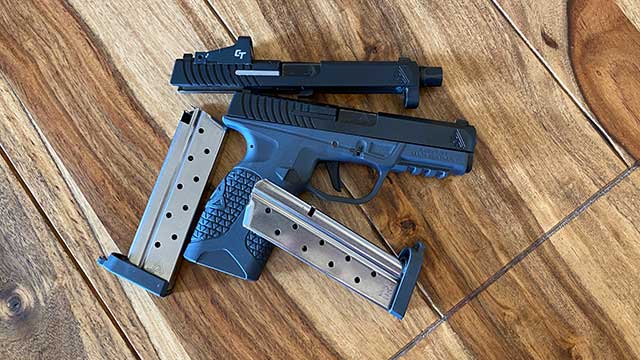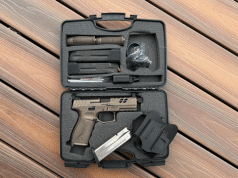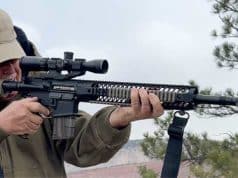The first time I ever visited the Pattern Room, the British Ministry of Defence’s spectacular reference collection of firearms— one of the best in the world — the curator told me to get ready, because everything I thought I knew about firearms was wrong.
He was right, but ultimately not in the way he (and I) thought. We, and I include myself in that, tend to see firearm development as a neat linear process, from breakthrough discovery to discount sales at the sporting goods stores. The reality is that the invention and the development of firearms down through the years is and has always been a sloppy business. Pick any famous firearms and the deeper you look in its history, the more than it is simply amazing that any of them made it to market. Just reading the history of Sam Colt and his revolver makes one wonder if it was possible to do get more things wrong!
While I’m sure we all think that is no longer the case, I’ve been behind the curtains enough times to know that all the sophisticated machinery in the world isn’t necessarily the ultimate solution to why or why not a gun is successful.
Let’s talk about the Avidity Arms PD10, first, because I think it is a very good gun, and, secondly, because of its unique genesis.
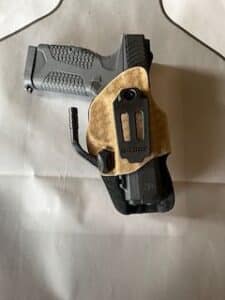
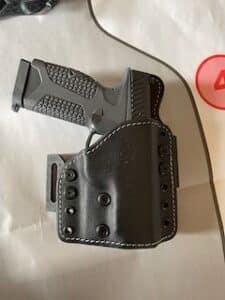
Two of the three holsters currently available for the PD10, including a Phenom Command IWB from G-Code and JM4 Tactical OWB “Relic.” A third holster from TACRIG, which you’ve seen featured on one of our TRIGGERED videos, is also available.
Although you’ve now heard it many times already, the Avidity Arms PD10 is the brainchild of trainer, entrepreneur, author and general gadfly Rob Pincus. Rob attracts controversy the way an overturned Budweiser truck attracts guys with mullets. Depending on the day of the week, the phase of the moon or perhaps something to do with the Pyramids, Rob is either the most hated or most loved person in the culture, and half the people on social media want him dead, or, at the very least, flayed alive.

What most of the social media venom misses is that that Rob Pincus is legitimately one of the most successful — and innovative — firearms trainers working today. His I.C.E. Firearm Training Services — I.C.E. stands for Integrity, Consistency and Efficiency, by the way —has trained thousands of students and certified dozens of instructors over two decades.
He is the Founder and Executive Director of the Personal Defense Network (PDN), creators of high-quality defense training videos featuring some of the top instructors in the world. Rob worked as my co-host on THE BEST DEFENSE, TBD/Survival and the Internet series TBD/Survival — PANDEMIC!
In addition, Rob works extensively with the U.S. Concealed Carry Association and much of their initial training materials came from him. He is the author of two of what I consider among the best self-defense books ever, DEFENSIVE SHOOTING FUNDAMENTALS and DEFENSIVE SHOOTING FUNDAMENTALS Level II, as well as his landmark COUNTER AMBUSH: The Science of Training for the Unexpected.
The reason I wanted bring up Rob’s bonafides is that social media makes it far too easy to actually overlook a person’s accomplishments while running down a rabbit hole of snark and venom. Rob has taught hundreds of students, certified dozens of instructors — including me — in his techniques and has added immeasurably to our understanding of how people react under potentially lethal stress.
The Avidity PD10 represents the first time that I know of that a self-defense firearm has been designed from the ground up by a veteran self-defense instructor, and his not necessarily noticeable touches are found throughout the PD10.
Spec Time!
Let’s run down the basics. The PD10 is a polymer-frame, striker-fire 9mm single-stack pistol geared toward the concealed carrier.
- Barrel Length: 4 inches
- Overall Length: 6.94 inches
- Width at Widest: 1 inch
- Slide Width: .9 inches
- Weight: 18.2
- MSRP: $599 ($625 with optics cut)
My understanding is that the first PD10s have gone out to retailers this week.
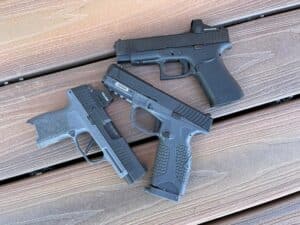
The PD10 compared in size to the Glock G48 (above) and the Sig Sauer 365XL Hybrid (left).
The first thing that stands out to me, and has stood out since I handled the first printed versions of the frame many years ago, is that the PD10 is thin…really really thin. If you’ve been following my work over the years, you will know that I consider thin to the maybe the single most important feature of a concealed carry gun. In numerous interviews I have listed the old Colt 1903/08 in .32 ACP and .380 as the ideal for an everyday carry gun.
The other important design parameters on the PD10 grip is that the heavily undercut tang and undercut trigger guard places the shooter’s grip high on the gun, which always helps in recoil control.
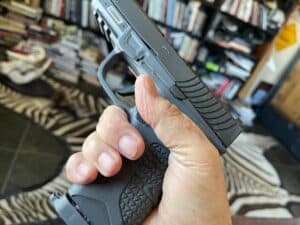
Note how high the hand rides on the grip frame…
The grip frame is also designed to fit a maximum number of hands. Gun “fit” is a surprisingly controversial subject. For example, a gun that feels perfect when handling at the gun store counter may not fit when the gun is under recoil. Rob’s original design parameters, as hammered out at a bar (where else?) in Germany in 2013 was a gun “that would fit as many human hands as possible. The handgun would be a slim, striker-fired 9mm semiautomatic that shot like a full-sized pistol but carried like a compact.” That’s from the obligatory manual that comes with the PD10, which is a miniature masterpiece in its own right…oh look, a firearms manual for grown-ups!
Yeah, but how does it shoot?
I have around 200 rounds through my loaner PD10, both through the iron-sight slide and the red-dot slide with the threaded barrel. I used a mix of 9mm rounds, including ARMSCOR 124-gr ball, Sig Sauer Match, some Winchester White Box and Federal 147-gr Syntech Training Match.
I had the gun lock back with one round remaining the in magazine on the first 2 mags through the gun. A slight change in my thumbs’ positions fixed that.
I found the gun easy to run…it’s snappy, but the gun and low bore axis offsets the snappiness.. I was able to run the gun fast, shooting at 7 and 10 yards…didn’t see anything out of the ordinary…I’ll save accuracy testing for my personal gun with my carry ammo (Hornady Critical Duty). It was boringly easy to stack all the shots right on top of each other. More than this you can’t ask!
Keep in mind that in 2013 the concealed carry revolution, as we term it, was in full swing, but the firearms industry was having a little trouble catching up. J-frame revolvers, the baby Glock G26, Officer’s Model 1911s and some outliers like the STI LS-9 (a very skinny sort of 1911 that I carried for several years), the 1995-introduced Kel-Tec P11 and the Kahr K-series were the cutting edge versions of EDC.
In that context, the readily available, already debugged 9mm 1911 magazine made a lot of sense. Because it was a metal magazine, the designed could take even more width out of the grip frame and still retain a 10+1 capacity

PD10 with Crimson Trace red dot sight and threaded barrel.
Let me just list out some other features on the frame that I like;
- The grip itself, one of the most comfortable, best-fitting handguns I’ve handled. And I’ve handed it to a bunch of different people and gotten the same response. I much prefer this to a bundle of different backstraps, which, if you’re like me, you will lose within the week.
- The grip texture, enough for a good grip but without the sandpaper texture that might either slow the draw or sand a nice hole in your clothes.
- Cutaway indentions at the base of the grip to facilitate “snatching” out a recalcitrant magazine.
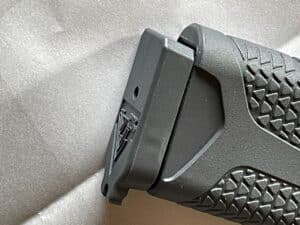
- You’ll notice that the design of the magazine baseplate also allows a solid grip if you have to pull the magazine free.
- The magazine release is large, but not so extended that you’re prone to dropping the magazine at an inopportune time.
- Slide stop is contoured and slightly protected.
- A textured point on the frame just above the forward edge of the trigger guard to provide an “index point” for the shooter’s trigger finger. This is, I think, an important element, especially with new shooters. When I instruct a new student to take his or her finger off the trigger, I like to give him or her a specific place to put it along the slide, and any kind of texturing adds a tactile element to that. It helps!
- Disassembly is what we might laughingly refer to as “Glock standard;” yeah, you gotta pull the trigger, so make real sure the gun is empty before you start disassembly!
- There is, of course, the ubiquitous rail, so feel free to add on.
- The magazine well is flared, and the mags drop free.
- Although the magazines are based on 1911 9mm magazines, they are specific to the PD10. I’m going to be trying some generic mags to see what happens, and I’ll let you know.
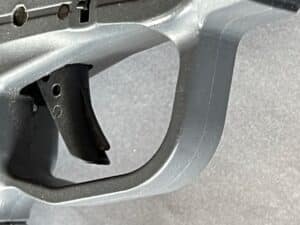
Trigger and safety tab are steel.
I like the trigger…it is steel, and smooth. The safety tab is also steel. It has the usual striker-fire take-up, followed by a bit of mush and then a crisp, 5-pound 5-ounce break off my Lyman digital gauge. Reset is short and quick, and I found it easy to run the gun quickly.
The slide has the usual rear serrations — no front serrations — a “bullnose” configuration to make holstering easier and a tactile loaded chamber indicator. Sights are an Ameriglo Luma Glow front and an I.C.E. CLAW rear sight. The CLAW was designed by Pincus right about the same time he started thinking about the PD10. The original design with it’s slight concave rear was to facilitate cycling the gun one-handed, hooking the rear sight on the holster, pants pocket or really nicely finished wooden table (which will leave a mark…ask me how I know this one). The rear sight opening is wide, which I hugely prefer. Yes, I know that a narrow rear with minimum light on either side of the front sight is the preferred choice for bullseye shooters and others focused primarily on marksmanship. Back in the ancient days of “combat shooting,” one thing I found myself doing on my 1911s was opening up the rear sight and/or using a narrower front sight. I wanted to see more of what was going on downrange because, unlike bullseye shooters, we needed to transition from target to target.
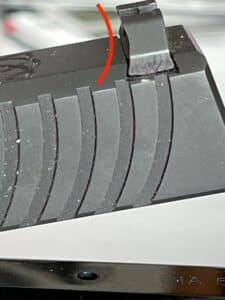
The Pincus-designed CLAW rear sight has a slight concave on the inside surface of the sight to ease one-handed operation.
The front sight has a tritium tube and is surrounded with a (thankfully) square florescent green box. Some of the earlier outlined tritium sights I’ve seen and used have a circle of reflective paint around the center night sight, much like you will see on the typical XS sight. Not that big a deal, but the correct sight picture involved a flat line along the top of the sight. I have often noticed that circles lacked such a flat line. Again, thoughtful touches.
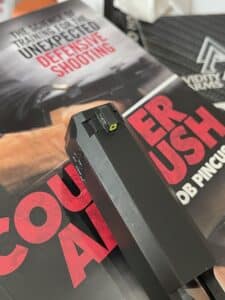
Dovetail front sight from Ameriglo.
Mine is Bigger than Yours…Maybe…
Let’s talk about size (of the gun…get your heads out of the gutter!), capacity and concealability.
Whenever we talk about concealed carry, or even self-defense for that matter, compromise is everything. One of the standing jokes I’ve used for years is in response to a question from someone who asked, “If you know you were going into harm’s way, what would you carry?”
I said I would carry a backpack loaded with Michael Seeklander and eight of his closest friends!
I think most sane people would agree that if we knew we were headed for a gunfight, we’d stay home and watch reruns of SHOOTING GALLERY and marvel at how young I was. In the world of self-defense, however, we spend a lot of time thinking about what’s likely to happen to us, what the statistics say, what the historical record shows, what’s the “flavor of the month” in training…and then we prepare and train for those things. But as one of my martial arts trainers once told me, if you think you know what’s going to happen in a fight, you’ve never been in a fight.
The PD10 is neither too large nor too small to successfully conceal for most people. I spent a couple of years using a G19 as my EDC, as well as carrying it on the road, to training classes and in USPSA match. I didn’t find the G19 particularly hard to conceal, nor do the many of my friends who carry a G19 or a G48 every day.
Concealed carry is ALWAYS a compromise. And it is, by its very nature, it is a personal compromise. It’s all on you. The longer you carry a gun, the more you know how to carry the gun and, honestly, the easier it gets. That’s why newer concealed carry holders tend to start out with the smallest gun they can find — I did. We start out thinking that the primary consideration of a concealed carry gun is its size. The longer we carry a gun, the more we understand how many other factors come into play.
Other personal considerations for compromises include grip size, magazine capacity, caliber, holster availability, fill in the blank. But those are decisions that you will have to make, not the cute man/woman behind the counter at the LGS or your 10 favorite YouTube content producers or what’s in this month AMERICAN RIFLEMAN.
The PD10 carries well in the G-Code…for me. I expect it to carry as well in the TACRIG, which I’ve used for the 365.
I look forward to getting my personal PD10, because I do really like the gun. I like the way it handles; I like the way it shoots The net net, as it were, is that Avidity delivered exactly what it said it would deliver, albeit not on the optimistic time frame they envisioned. I look forward to carrying it and shooting the PD10 a lot more!

